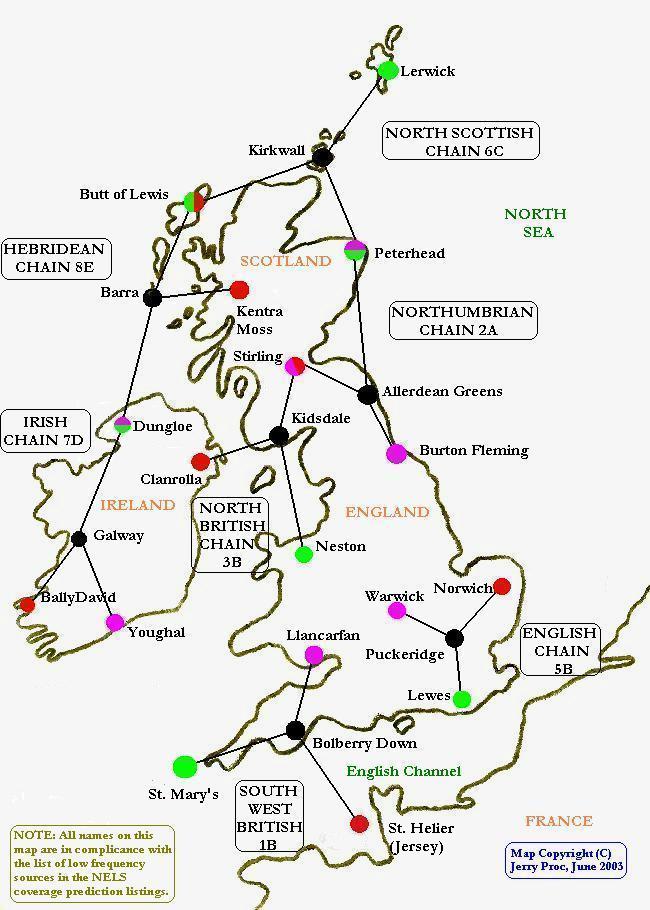 |
 |
This map illustrates the locations of the former Decca chains in the UK. (Graphic by Jerry Proc)
Mr. Alfred Barnes, British Minister of Transport, presses the button which inaugurated the English Chain 5B at Puckeridge in 1946. (Image provided by John Molloy-Vickers)
ENGLISH CHAINJohn Molloy-Vickers recalls an experience early in his career. "When I joined Decca Navigator in 1957, my first contact with a live Decca station was at the Green Station of the English Chain at East Hoathly, where I was put on watchkeping duties for a week as an initiation. The station had just been converted to Mk 10 and the old Mk 5 control racks were there as well as the Mk 10 racks. The idea was that if the new Mk 10 racks failed, one could manually switch back to the old racks. This meant constant surveillance by the watchkeeper and much wringing of hands if a clean changeover was not made! The Station Engineer at that time was John Pratt, I believe".
DUAL SLAVE STATION TUNING
by Doug SimThe Northumbrian and Hebridean chains used “Dual-tuning”, where the same coils, capacitors and mast were used for transmissions from both chains (as opposed to co-located stations, where two sets of coils and masts were sited to use the same transmitter buildings and operating staff). This had considerable savings in installation costs.
Sharing of mast and coil was done by changing the tuning of the aerial coils for each part of the transmission sequences using thryistors. The first station to have this installed was Stirling in Scotland, which was shared by North British and Northumbrian chains.
The photo below shows a typical installation. The huge Dubilier oil-filled capacitors can be seen at the top. Beneath this is the switching unit for each coil. The switching thyristor uses one of the aluminium channels as a heat sink. The grey box contains the electronic interfacing and trigger circuits.
Modification of the coils was a white knuckle ride. 12 hours only was allowed, as one slave was lost on an operating chain, and it was done on a Sunday to minimise inconvenience. Normally aerial tuning work was done by field engineers, but for the dual-tuned stations, a senior specialist from the aerial and transmitter labs in New Malden was sent into the field.
The huge aerial coils had their litz wire chopped and re-terminated to the Thyristor switches. Once started, there was no going back. At switch-on, the priority was to re-tune the coils for the existing slave transmissions before 12 hours was up. After this, the additional slave transmissions had to be optimized “on the fly” in synchronization with the existing chain. Dungloe (Irish Chain) and Stirling (North British) were dual stations. Butt of Lewis was co-located.
See text for explanation. (Photo courtesy Doug Sim).
LITZ WIREDavid Jones offers an insight on stripping Litz wire. "The Decca coils were made with 750 strand Litz wire and the earlier type had to be solvent stripped to remove the varnish from the copper strands. Later it became solder activated. When I worked with it, the preferred method of cleaning the ends was to cut off the outer jacket,
remove the wound cotton layer and then plunge it into a solder pot. When the flux and solder finished bubbling, the wire was removed and wiped cleanly with a cloth in a twisting motion. No goggles were used nor was there any fume removal system in place. Just squat on the copper sheet floor in shorts and "flip-flops". Hopefully, the
mosquitoes were killed by the fumes.
Jim Bain of Racal-Decca Marine Navigation, provided some details about the modernization program for the UK Decca chains.Puckeridge was the first station to undergo conversion and the entire English chain took 3 months. The S.W. British chain was completed around August 1993 with the remaining chains completed by May 1994. In September, a centralized station called Super Control was set up in Edinburgh. It had the capability to control all 6 British chains. The modernized equipment had one huge impact on personnel - it reduced the head count from 61 to only 19 engineers!
By the time the modernization was completed, it was sadly realized that the Decca company would never sell another chain and very unlikely that any jurisdiction would want to modernize their existing equipment. With chains starting to close in the mid 1990's, the beginning of the end had started.
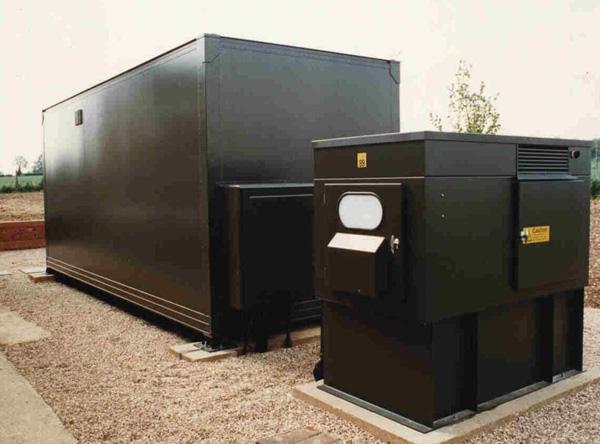 |
| This was the modernized Decca station consisting of a two piece shelter.
The larger of the two housed the transmitting gear and was comprised of
aluminum inner and outer skin with a polyurethane filler having a high
insulation factor. It's dimensions were: Length - 6.1m; Width - 2.4m;
Height - 2.7m.
The smaller of the two was the standby generator. It consisted of an air cooled, 3 cylinder, Lister Petter diesel coupled to an 18 KVA alternator. This Motor-Alternator sat on top of a 700 liter fuel tank which provided sufficient capacity to run the station continuously for 10 days. Surrounding the M-A was an acoustic baffle which provided sufficient noise isolation and made it possible to carry on a on normal conversation while in close proximity to the equipment. The shelters were fully fitted at Stevenage then shipped to site where the external connections were made. (Photo provided by John Molloy-Vickers) |
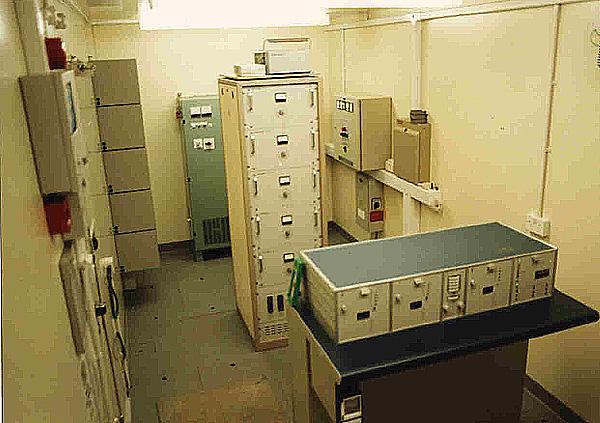 |
| In the lower right portion of the photo is the phasing control sitting
on the table. In the center, is the rack containing the five transmitters
(5000 series) and the green cabinet behind it was the two bay, battery
charging panel. At the very left is the fire control panel with the RF
terminal board and power feeders behind it respectively. On the right side,
from front to back, was the AC distribution panel and the diesel controller.
Beneath the floor was a 72.5 volt (high tension) battery bank whose output could sustain the station for 14 hours. A DC-to-DC converter (out of view, lower right) provided a 27 volt low tension output. The approximate power load for this entire facility was around 5.5 KW. (Photo provided by John Molloy-Vickers) |
The Decca Navigator was a system of providing ships and aircraft with their position by measuring the difference in time of arrival of radio transmissions from several transmitters simultaneously by using their phase. It took its name from The Decca Record Company, famous for its LP records of the 1940's and 50's and still perpetuated in re-releases of its landmark recordings. Transmissions were in the low-frequency band between 70 and 127 kHz and could be heard on A.M. as a series of periodically interrupted melodic tones centred around 71, 85, 112 and 127 kHz - no doubt many amateurs heard it while they were tuning around. At its peak in the 1960's and 70's, it was used by more than 35,000 ships and 10,000 aircraft but like many other radio-navigational systems it was overtaken by satellite technology in the form of the American GPS. Latterly it was operated by the Racal company (who bought Decca in 1981) on behalf of the Department of Transport, and in the face of an almost complete turnover by navigators to GPS it was decided to close it down. The closure of the British transmitters occurred at midnight on March 31st , 2000, followed shortly by the shutdown of the Irish chain. Since all other European transmitters had already closed, that has left only the Japanese still running Decca chains, but due to close at the end of this 2001.Decca had 21 transmitting sites in the UK using a mixture of antennas. The original Decca chain covering the English East and South coasts, the English 5B Chain, was built in 1946 and, as often happens with the first of anything, no expense was spared to ensure it worked properly. It used self-supporting vertical masts 325 ft (100m) high with an extensive ground plane of copper radials also 100m long fanning out every 10° around it (Fig 1). It had an efficiency of around 10% at the lowest frequency (71 kHz) and a transmitter output of 1.2 kW provided 120 watts radiated, easily enough, it was thought, to cover the whole of the UK with just one chain.
Unfortunately it was found that skywave destroyed accurate phasing at much shorter ranges than had been anticipated, and the only answer was to use more chains with restricted range. This meant that smaller aerials only 165 ft high, (and much cheaper than 325 footers!) could be used. The UK therefore ended up with six chains each with four transmitters so, from April 1st, 2000 there were 21 excellent LF masts and sites throughout the UK (some did double duty for two chains) doing nothing for a short period until they were either demolished or turned to other uses.
Amateurs on the 73 kHz and 136 kHz band have always been handicapped by their inability to erect decent aerials - at 73 kHz a half-wave is over 2 kms long - so aerial efficiencies were very low and even to radiate the permitted 1 watt needed kilowatt amplifiers. In spite of this, considerable distances were worked on both bands - the record currently stands at 2200 kms, OH1TN to IK1ODO. But the matter of big versus small aerials became a subject of hot debate within the LF Group and many opinions were aired on whether they were worthwhile. Did a big antenna have a different radiation pattern from a small one? Should it be very high vertically or would it be much the same if it were very long horizontally? It seemed to be rather a sterile debate until it became known the Decca antennas might be available for a few weeks and thoughts turned to seeing whether one could be used for a comparison test. At one time it seemed a forlorn hope because of legal and insurance problems but eventually they were overcome with the result that Racal granted temporary permission to use one 325 ft antenna, that at Puckeridge, Herts. for a time slot of only three weeks that was only two weeks away. The next hurdle was to find out whether authorisation could be obtained to radiate higher power than 1 watt. Thanks to considerable assistance from the RSGB this was cleared in the record time of only one week, permission being obtained for the Crawley ARC station, G3WSC, operating at Puckeridge, to radiate up to 100w on both 73 and 136 kHz, with the added bonus of a time extension on the 73 kHz band, as already reported in this magazine.
Racal required that use of their site was to be handled only through the author and to help with this I had the invaluable assistance of G3GRO, Derek, G3LDO, Peter, and G3KAU, Lech, all well known on the LF bands. A request on the LF reflector brought in a number of other amateurs who were interested in transmitting from this mast and a suitable roster was devised. G3GRO/G3KAU wanted to get going as soon as possible so made a preliminary reconnoitering trip up to Puckeridge since no Racal/Decca equipment could be used and everything needed had to be brought on site. Puckeridge is a manned station (the others are remotely controlled) and they had considerable assistance from the resident engineer, Dick Caddy. Directly under the mast there was a coil house that had once housed the Decca antenna tuning unit coils which was big enough to hold the transmitters, receivers and other gear. Fortunately it had mains power laid on and even had heaters, very welcome in the cold evenings of early April. The electrical characteristics of the antenna were obtained from Racal (3750 pf in series with 5 ohms and 12 uH) enabling re-design of Derek's ATU once he was back home so that when he returned he could just plug it in and go.
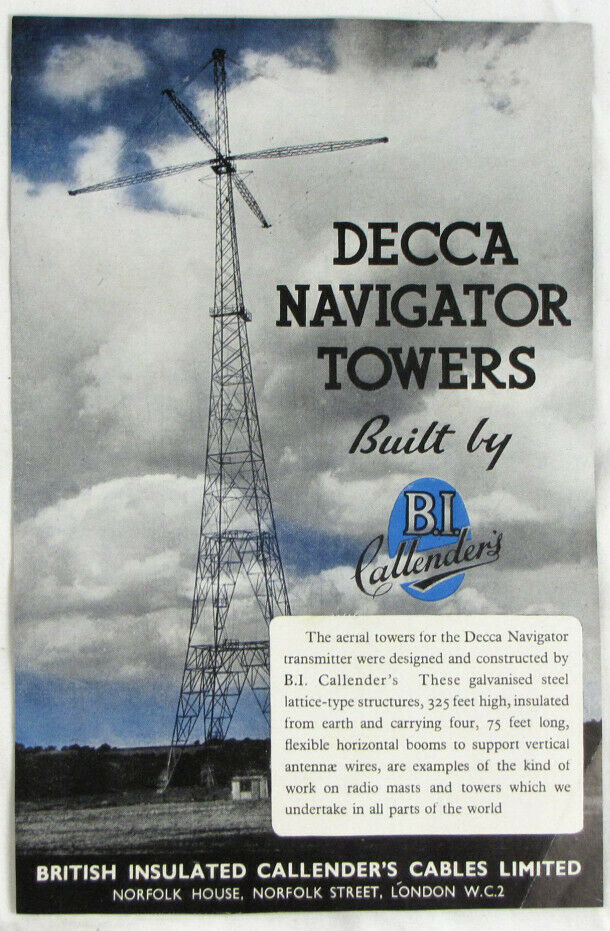 |
| This 325 foot self supporting tower was the original one installed at all the stations in the English Chain 5B It was manufactured by Callender's Cables. Each boom was 75 feet long in order to support the vertical radiating wires. This appears to be the only tower style of its kind in the Decca Navigator System.. The ad appeared in an 1947 periodical, . (Image via E-bay) |
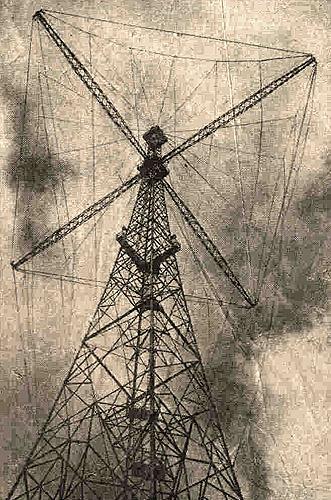 |
| The original Decca mast at Puckeridge from an
old newspaper photo taken in 1946. The crossarms were later removed, likely
to save on maintenance and painting costs. In that case, it would
have been necessary to add additional dressing wires to the
main mast in order maintain "tune". In the UK, the masts were maintained
by Balfour Beatty, a civil engineering contractor that also handled large
steel structures.
The typical Decca tower used a single, guyed, square lattice structure, about 3 feet square and 300 feet tall. (Photo via Walter Blanchard) |
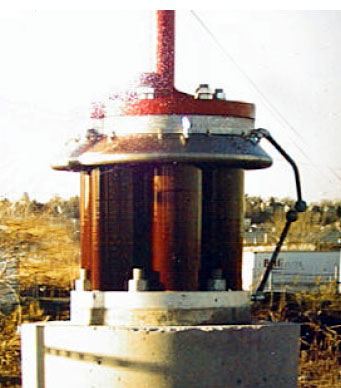 |
| This is typical of the insulator assembly which was fitted to each of four legs which supported the tower. There was a top hat and dressing wires to set the mast capacitance figure. Note the lighting arrester (two balls ) on the right side of the insulator. (Image courtesy Austin Insulators) |
Derek G3GRO reported on the first weekend (14-15-16th April 2000):Apart from the Decca mast and an RF thermocouple ammeter, none of the original equipment such as loading coils etc. was used. For 136Khz operation, a relatively small variometer (about 500uH max) and a tapped toroidal auto transformer were connected to ground from the copper pipe lead into the base of the mast which is supported on 4 massive ceramic insulators. The exploratory visit earlier in the week (11th April) allowed a purpose built additional loading coil for 73Khz to be built by Lech G3KAU back at base in time for the main exercise at the weekend. On 136Khz we did not need any additional loading coil, in fact to start with, we had to insert in series with the antenna one of the very large 500pf 25KV wkg capacitors we found lying outside the hut. Later on at the weekend we discovered that by moving the input/output taps down the auto transformer to reduce the base inductance but keeping the same ratio, we avoided the need for the series capacitor in the antenna lead.
Three transmitters were employed at various times; the G3GRO 300W much modified BKE linear amplifier was used for the 1W ERP tests on 73/136Khz earlier in the week and then on Friday and Saturday for running between 1 and 5W ERP.Additionally we used the well tried G0MRF 500W setup and the G3YXM 1Kw class D rig used previously on many expeditions. The BKE linear was driven from a FT990 transceiver via a 100:1 digital divider and BPF from either 136 or 73 kHz. During the overnight sessions on Friday in beacon mode, the ERP was 50W and 100W ERP overnight Saturday. We had a few problems to start with in getting the variometer to handle the 500W RF and we had a few splatts and sparks resulting in VSWR trips until we realised that the capacitive voltage divider in the forward/reflected power meter in the variometer was tracking over and bypassed it. Fortunately we had another SWR meter in line. We also found that an RF sampler unit brought along by Jim M0BMU very useful in setting up the matching and tuning in conjunction with an oscilloscope. We realised on Saturday that the range of our RF ammeter was too small for the high power operation and rescued the original very large 30A RF ammeter from the pile of redundant scrap units outside in the rain and pressed it into service.
During the beacon sessions it was reading 14A into the base of the mast which looks like 5 ohms resistive (mainly due to the earth) in series with 3750pf ! That represented an RF power of 1Kw into the antenna - about 100W ERP allowing for an overall antenna efficiency of 10% on 136Khz. One modification we made between the early session and later was to change to keying the emitter of the buffer amplifier following the divide by 100 stage with added keying shaping to minimise key clicks which had been reported. That seemed to completely clear that problem although we found out later it was also present at least one of the class "D" transmitters used for the higher power sessions and night time beacon sessions.
The receive system was a homebrew up-converter with an input bandpass filter of about 3khz bandwidth on both 73 and 136kHz followed by a Minicircuits MAR6 preamp and MC1496 mixer IC to a 10 MHz IF feeding both a FT990 and IC756 transceiver for most of the time. The FT990 and converter stood up remarkably well to the very large antenna input with no sign of cross modulation. We had a switched the attenuator at the input to the converter but for most of the time it was switched out. We had two operator positions side by side, one handling the 136 and 73 traffic and the second op also monitoring 136/73Khz in parallel but also handling the HF cross band input mainly from 7.0 Mhz.
I think that one of the nice things about the operation was that with such a big signal, we could easily be heard by stations with a very simple antenna not specifically tuned to LF and give quite a few cross band stations their first QSO with an LF station. I think the other memory was of having to make several journeys humping all the gear a couple of hundred metres through the pouring rain and climb over a low fence with the gear and through all the grazing sheep in the compound!
G3XDV had a few memories too!
A - The continuous rain that soaked through my coat and made it weigh a ton, then went on to soak the rest of my clothes. I remember thinking that I had spent my school days avoiding sporting activities involving getting cold and wet, but this was by no means the first radio expedition that had resulted in just that.
- I also had an agonising hip problem that started to get better from that day on ? must be the healing powers of LF RF (RF gets a bad press these days!).
- On the arrival of reinforcements, YXM, XTZ, MRF, BMU and myself went to the local pub for a warm up and refreshments only to be told that there was a wedding reception on and there was no food. They eventually took pity on us dripping into our crisps and offered 'something and chips' which went down VERY well.
- Also at one point it occurred to us that there wasn't any point in going on the 73kHz band since 90% of the active licensees were in the same room at Puckeridge.G3GRO's summary of results for the first weekend :
There were about 65 QSOs in total including those during the initial setting up period on Tuesday 11th of April. Two-way contacts were made on both bands and cross band contacts from 136Khz to 73 kHz and to 7.0 Mhz. There have not been any reception reports from across the pond from VE or W which was always going to be a long shot, but the longest contact was cross band to 7.0Mhz with Alex, UB5WF in KN58JQ about 200Km north of Odessa on the Black Sea who gave us RST429. normal CW at a distance of 2225Km! This was over a daylight path at 1232 UTC on Sunday 16th. It is not known yet what RX antenna Alex had for 136Khz but it is highly unlikely that it was a dedicated LF antenna since there is as yet no LF activity in Russia as far as is known. Other long distance QSOs were to Valerio, IK5ZPV 2-way on 136 who gave us RST589; IK7HSS cross band to 7.0Mhz, and Neils OZ8NJ (2-way 136) who QSP'd to us that IK5ZPV was hearing us and would call us shortly. We also got a RST 599 on 136Khz from Christer SM6PXJ , OZ5N and Toni HB2ASB. Two QSOs were also made on both 136 and 73 kHz to Finbar EI0CF and Ray GI3PDN. Reports on 73 kHz were about 2 S-points down with Ray and Finbar by comparison with 136Khz. We also worked GJ4CBQ and GU3SQX cross band 136 Khz/7.0 Khz which was pleasing since due to Loran QRM from Lessay they normally have difficulty in hearing stations on 136Khz.
Perhaps one of the most unusual QSOs was with Graham G3XTZ/M operating mobile on 136Khz CW whilst driving to the site to have a spell of operating! We also had a report via E-mail from Marc F5MAF in Toulouse, JN03PP who was hearing us at 599+ on a 2 meter diameter loop at a distance of 900 Km and bemoaning the fact there is no LF activity in his neck of the woods. Later, email reports on the 71.8 kHz signals were received from Walter, DJ2LF (569 in JN59NO), and Geri, DK8KW (579 in JO52BH - 697 kms).
Thanks to all those who took part despite the very wet and freezing cold weather and also to those who took the trouble to give us reports which have yet to be analysed. At one point on Saturday as the shifts changed over there were 12 people in the ATU shack at the base of the mast which represented a large slice of the active UK LF operators! They were : G3KAU, G3XDV , M0BMU, G0MRF, G3XYM, G3XTZ, G3YSX, G4GVC, Kate G4JAI, XYL GVC, G4TSH, G3LHZ , G3GRO not forgetting Peter G3LDO holding the fort back home and Walter G3JKV who efforts made it all possible.
The report of reception by UB5WF at 2225 kms, in daylight and over a predominantly land path, was especially interesting. This is about two-thirds of the way to Canada - Newfoundland is 3520 kms from Puckeridge and has mainly a sea path so the signal would only have had to travel another 1300 kms to make it all the way to Canada. Unfortunately at these ranges the 136 kHz ground wave signal is falling off very rapidly and according to the CCIR propagation curves another 35 dB would be needed, even over sea water. Just possibly it could be done at a very low noise site using one of the FFT programs for reception. Larry, VA3LK, is already taking steps to set up an LF station for this purpose, although it is not known whether Puckeridge will be available next winter when skywave might help.
Overnight on the 15th April G3WSC was left on the air running continuously as a beacon with an estimated radiated power of 100 watts. This generated a number of listener reports and according to Vaiski, OH2LX, who has some very accurate measuring receivers, the signal strength was not far below that of some of the commercial stations near the band.
Apart from this DX work, as already mentioned a long standing discussion within the LF group has been about the differences between large and small aerials. Given the same radiated power, is there any difference in signal strength between them? After all, both are very small in terms of wavelength. To try to resolve this, Jim, M0MBU, decided to set up a small aerial at Puckeridge fairly near the big stick; radiate the same power from both alternately, and see what reports he got. Surprisingly, the small aerial got slightly better reports, by about 4 dB, and Jim's remarks on this were:
Coupling between antennas
Several people raised concerns about the coupling effects that might exist between the two antennas. If sufficient power was being coupled into the big antenna to materially affect the overall radiated signal, one would expect significant current to be flowing in the big antenna while transmitting from the small antenna, but there was none. Even with the big antenna resonant, the current induced in it by the small antenna was too small to contribute a significant fraction of the radiated power.
Radiation Resistance:
The radiation resistance (20 milliohms) of the small antenna was easy to calculate due to it's simple geometry. The Decca mast was much more complicated - the exact radiation resistance depends on how thick you make the various conductors however, the variation is not that great. I settled on a value of 0.65 ohms. If we assume that the 4dB difference in signal strengths was entirely due to the 0.65 ohms value being in error, the correct R rad would have to be about 0.26 ohms to make the figures work out. I can't see how it would be this low, however.
in summary, I chose the values of 0.02 ohms and 0.65 ohms for small and big antennas as the consensus of a number of estimates, and would be surprised if the errors in the values were big enough to explain the differences observed in field strengthsPossible Causes:
My money is on the increased field strengths being due to fields and currents under the ground surface, resulting in greater effective height of the small antenna. Obviously, this needs more investigation, which I hope to try later.
Conclusions:
The main point about this experiment was that, provided sufficient transmitter power is available, a small antenna can be made to radiate a given value of ERP just as well as a big one. This was borne out by the comparative signal reports. Of course, the big antenna will require much less transmitter power to do it, and will electrically be much more stable, a Decca requirement for compete phase stability. This is not a big surprise, and confirms the result that we got at the previous Puckeridge expedition. What is more surprising is that the small antenna seemed to be more efficient (or perhaps 'less inefficient' would be a better way of putting it) than would be expected from theory.
What is more directly important is to find out the different factors that affect the power radiated by small antennas, so that this information can be used by LF amateurs to generate better signals. It is already clear that field strengths (and therefore ERP) depend on many more things than are taken into account in the simple antenna theory we use, and so the ERP figures that we give out have little relation to reality. I hope soon to do some more experiments with different antenna environments in the hope of throwing some light on this.
Jim Moritz, M0MBU
This was a most interesting experiment and should give encouragement to those who can only get up small aerials for the LF bands (most of us!). Together with the powerful LF signal radiated by G3WSC enabling many who had never heard anything on the LF bands to do so, and the straightforward DX aspects, this must have been one of the most successful amateur radio experiments of recent times.
Walter, G3JKV.
Apr 15/21